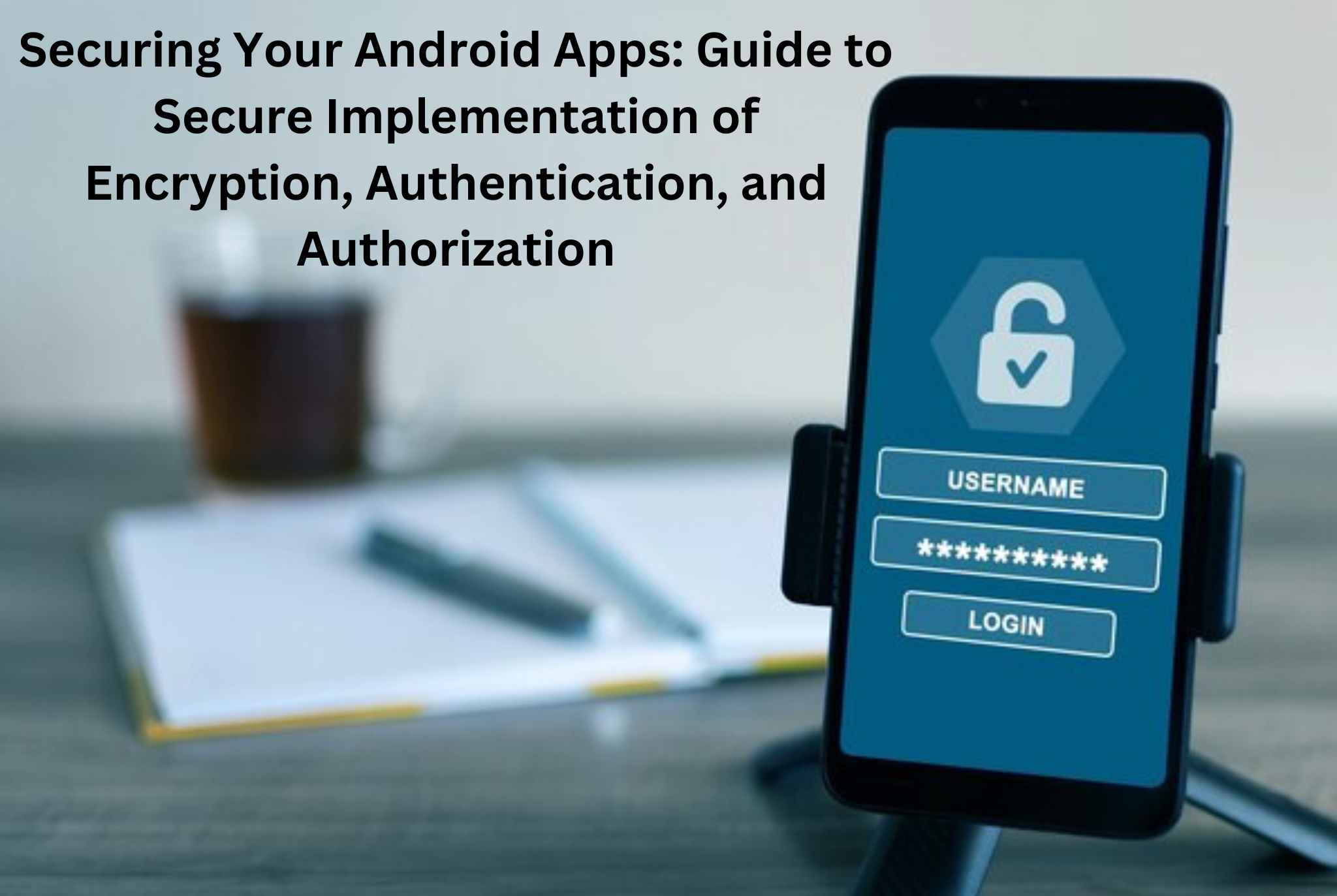Smartphone application through robust encryption, authentication, and authorization techniques. By implementing these strategies, you can safeguard sensitive data and protect your users’ privacy.
Encryption
- Encryption plays a vital role in securing user data on Android devices.
- Encryption is the process of transforming data into an unreadable format using a secret key. This ensures that only authorized parties with the decryption key can access the original data.
- Understanding the fundamentals of encryption: symmetric vs. asymmetric encryption, hashing, and salting.
- Selecting appropriate encryption algorithms and key management strategies for Android apps.
- User Model
public class User {
private String username;
private String password; // Hashed password (not plain text)
// Getters and Setters
}- Secure Password Storage (using Hashing):
public class SecurityUtils {
public static String hashPassword(String password) {
// Use a strong hashing algorithm like bcrypt or scrypt
return BCrypt.hashpw(password, BCrypt.gensalt(10));
}
public static boolean verifyPassword(String plainTextPassword, String hashedPassword)
{
return BCrypt.checkpw(plainTextPassword, hashedPassword);
}
}
The User model stores the hashed password, no longer the obvious textual content password. This prevents retrieving the original password even supposing the database is compromised.
The SecurityUtils provides methods for hashing passwords (using BCrypt in this case) and verifying them for the duration of login.
Implementing Secure Authentication
- Exploring various authentication methods and their suitability for different scenarios.
- Authentication Methods:
- Username & Password:
- Multi-Factor Authentication (MFA)
- Token-Based Authentication:
- Best practices for securely storing and managing user credentials on the device.
- Implementing secure authentication flows using libraries like Firebase Authentication or OAuth 2.0.
Implementing secure authentication flows using libraries like Firebase Authentication or OAuth 2.0.
- Login Activity
public class LoginActivity extends AppCompatActivity {
private ActivityLoginBinding binding;
@Override
protected void onCreate(Bundle savedInstanceState) {
super.onCreate(savedInstanceState);
binding = ActivityLoginBinding.inflate(getLayoutInflater());
setContentView(binding.getRoot());
// Login button click listener
binding.loginButton.setOnClickListener(new View.OnClickListener() {
@Override
public void onClick(View v) {
String username = binding.usernameEditText.getText().toString();
String password = binding.passwordEditText.getText().toString();
// Hash the entered password for comparison
String hashedPassword = SecurityUtils.hashPassword(password);
// Authenticate user with username and hashed password (backend call)
authenticateUser(username, hashedPassword);
}
});
}
private void authenticateUser(String username, String hashedPassword) {
// Call your API here to authenticate the user with username and hashed password
// ...
// If successful, store a secure token for authorization
storeAuthToken(// ...);
// Start main activity
Intent intent = new Intent (LoginActivity.this, MainActivity.class);
startActivity(intent);
}
}The login activity retrieves username and password from the edit texts.
The password is hashed before sending it for authentication.
Upon successful login, a secure token (e.g., JWT) can be stored for authorization in subsequent requests.
Secure Storage and Data Handling
- Safeguarding sensitive data in transit and at rest using encryption and secure storage techniques.
- Implementing data encryption for local databases, Shared Preferences, and file storage.
- Securely transmitting data between client and server using HTTPS and encrypted communication protocols.
- Secure Storage Mechanisms: Shared Preferences, KeyStore, Android Room with Encryption
- Best Practices for Data Handling: Validate User Input, Secure Network Communication, Regular Backups, Clear Data on Logout or App Uninstall
- Secure Storage (for Auth Token)
public class SharedPrefManager {
private static final String PREF_NAME = "MyApp_Prefs";
private static final String KEY_AUTH_TOKEN = "auth_token";
private static SharedPreferences getSharedPreferences() {
return getApplicationContext().getSharedPreferences(PREF_NAME,
Context.MODE_PRIVATE);
}
public static void storeAuthToken(String token) {
SharedPreferences.Editor editor = getSharedPreferences().edit();
editor.putString(KEY_AUTH_TOKEN, token);
editor.apply();
}
public static String getAuthToken() {
return getSharedPreferences().getString(KEY_AUTH_TOKEN, null);
}
}The SharedPrefManager class provides secure storage for the auth token using SharedPreferences with a private mode.
The token is retrieved for subsequent API calls requiring authorization.
Authorization: Controlling Access
- The user is successfully authenticated, and authorization comes into play. It determines what actions or resources a user is allowed to access within the app.
- There are different authorization models you can implement in your app.
- A common approach is Role-Based Access Control (RBAC). Users are assigned roles (e.g., admin, editor, viewer) with predefined permissions.
- Effective authorization is crucial for protecting your app’s data and functionalities.
- By Understanding and implementing authorization correctly, you can build a more secure and user-friendly application for Android phones.
- Authorization Activities
public class ProtectedActivity extends AppCompatActivity {
@Override
protected void onCreate(Bundle savedInstanceState) {
super.onCreate(savedInstanceState);
setContentView(R.layout.activity_protected);
String authToken = SharedPrefManager.getAuthToken();
if (authToken == null) {
// User is not authorized, redirect to login
Intent intent = new Intent(ProtectedActivity.this, LoginActivity.class);
startActivity(intent);
finish();
} else {
// Make authorized API calls using the auth token
// ...
}
}
}The protected activity checks for the presence of an auth token before allowing access to sensitive features.
If the token is missing, the user is redirected to the login activity.


